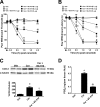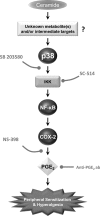Intraplantar-injected ceramide in rats induces hyperalgesia through an NF-κB- and p38 kinase-dependent cyclooxygenase 2/prostaglandin E2 pathway
- PMID: 21551240
- PMCID: PMC3136338
- DOI: 10.1096/fj.10-178095
Intraplantar-injected ceramide in rats induces hyperalgesia through an NF-κB- and p38 kinase-dependent cyclooxygenase 2/prostaglandin E2 pathway
Abstract
Inflammatory pain represents an important unmet clinical need with important socioeconomic implications. Ceramide, a potent proinflammatory sphingolipid, has been shown to elicit mechanical hyperalgesia, but the mechanisms remain largely unknown. We now demonstrate that, in addition to mechanical hyperalgesia, intraplantar injection of ceramide (10 μg) led to the development of thermal hyperalgesia that was dependent on induction of the inducible cyclooxygenase (COX-2) and subsequent increase of prostaglandin E(2) (PGE(2)). The development of mechanical and thermal hyperalgesia and increased production of PGE(2) was blocked by NS-398 (15-150 ng), a selective COX-2 inhibitor. The importance of the COX-2 to PGE(2) pathway in ceramide signaling was underscored by the findings that intraplantar injection of a monoclonal PGE(2) antibody (4 μg) blocked the development of hyperalgesia. Our results further revealed that COX-2 induction is regulated by NF-κB and p38 kinase activation, since intraplantar injection of SC-514 (0.1-1 μg) or SB 203580 (1-10 μg), well-characterized inhibitors of NF-κB and p38 kinase activation, respectively, blocked COX-2 induction and increased formation of PGE(2) and thermal hyperalgesia in a dose-dependent manner. Moreover, activation of NF-κB was dependent on upstream activation of p38 MAPK, since SB 203580 (10 μg) blocked p65 phosphorylation, whereas p38 kinase phosphorylation was unaffected by NF-κB inhibition by SC-514 (1 μg). Our findings not only provide mechanistic insight into the signaling pathways engaged by ceramide in the development of hyperalgesia, but also provide a potential pharmacological basis for developing inhibitors targeting the ceramide metabolic-to-COX-2 pathway as novel analgesics.
Figures







Similar articles
-
Cyclooxygenases 1 and 2 contribute to peroxynitrite-mediated inflammatory pain hypersensitivity.FASEB J. 2008 Sep;22(9):3154-64. doi: 10.1096/fj.08-108159. Epub 2008 May 22. FASEB J. 2008. PMID: 18497304
-
Peptidoglycan-induced IL-6 production in RAW 264.7 macrophages is mediated by cyclooxygenase-2, PGE2/PGE4 receptors, protein kinase A, I kappa B kinase, and NF-kappa B.J Immunol. 2006 Jul 1;177(1):681-93. doi: 10.4049/jimmunol.177.1.681. J Immunol. 2006. PMID: 16785567
-
Release of prostaglandin E(2) and nitric oxide from spinal microglia is dependent on activation of p38 mitogen-activated protein kinase.Anesth Analg. 2010 Aug;111(2):554-60. doi: 10.1213/ANE.0b013e3181e3a2a2. Epub 2010 Jul 7. Anesth Analg. 2010. PMID: 20610553
-
Enterovirus 71 induces COX-2 expression via MAPKs, NF-kappaB, and AP-1 in SK-N-SH cells: Role of PGE(2) in viral replication.Cell Signal. 2010 Feb;22(2):234-46. doi: 10.1016/j.cellsig.2009.09.018. Epub 2009 Oct 1. Cell Signal. 2010. PMID: 19800403
-
Peptidoglycan induces cyclooxygenase-2 expression in macrophages by activating the neutral sphingomyelinase-ceramide pathway.J Biol Chem. 2009 Jul 31;284(31):20562-73. doi: 10.1074/jbc.M109.028084. Epub 2009 Jun 15. J Biol Chem. 2009. PMID: 19531467 Free PMC article.
Cited by
-
Protective Effect of Antioxidants in Nitric Oxide/COX-2 Interaction during Inflammatory Pain: The Role of Nitration.Antioxidants (Basel). 2020 Dec 16;9(12):1284. doi: 10.3390/antiox9121284. Antioxidants (Basel). 2020. PMID: 33339104 Free PMC article.
-
Engagement of the GABA to KCC2 signaling pathway contributes to the analgesic effects of A3AR agonists in neuropathic pain.J Neurosci. 2015 Apr 15;35(15):6057-67. doi: 10.1523/JNEUROSCI.4495-14.2015. J Neurosci. 2015. PMID: 25878279 Free PMC article.
-
The Sphingosine 1-Phosphate Axis: an Emerging Therapeutic Opportunity for Endometriosis.Reprod Sci. 2023 Jul;30(7):2040-2059. doi: 10.1007/s43032-023-01167-2. Epub 2023 Jan 20. Reprod Sci. 2023. PMID: 36662421 Free PMC article. Review.
-
Potential Effect of Etoricoxib in Reducing Inflammation in Methotrexate-Induced Pulmonary Injury in Rats: Role of Oxidative Stress and the TLR4/p38-MAPK/NF-κB Signaling Pathway.Inflammation. 2025 Aug;48(4):2407-2416. doi: 10.1007/s10753-024-02198-w. Epub 2024 Nov 27. Inflammation. 2025. PMID: 39602008 Free PMC article.
-
Reversible suppression of cyclooxygenase 2 (COX-2) expression in vivo by inducible RNA interference.PLoS One. 2014 Jul 2;9(7):e101263. doi: 10.1371/journal.pone.0101263. eCollection 2014. PLoS One. 2014. PMID: 24988319 Free PMC article.
References
-
- Hannun Y. A., Obeid L. M. (2008) Principles of bioactive lipid signalling: lessons from sphingolipids. Nat. Rev. Mol. Cell. Biol. 9, 139–150 - PubMed
-
- Delgado A., Casas J., Llebaria A., Abad J. L., Fabrias G. (2006) Inhibitors of sphingolipid metabolism enzymes. Biochim. Biophys. Acta 1758, 1957–1977 - PubMed
-
- Joseph E. K., Levine J. D. (2004) Caspase signalling in neuropathic and inflammatory pain in the rat. Eur. J. Neurosci. 20, 2896–2902 - PubMed
-
- Vane J. R. (1971) Inhibition of prostaglandin synthesis as a mechanism of action for aspirin-like drugs. Nat. New Biol. 231, 232–235 - PubMed
Publication types
MeSH terms
Substances
Grants and funding
LinkOut - more resources
Full Text Sources
Other Literature Sources
Research Materials
Miscellaneous

